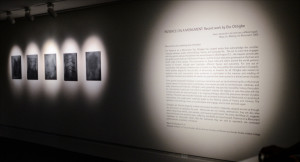Patience on a Monument:Works of Eto Otitigbe, Curated by Myron Beasley
Any historical narrative is a bundle of silences.
Michel-Rolph Trouillot
Every memorial in its time has a different goal.
Maya Lin
We experience our present world in a context which is causally connected with past events and objects, and hence with reference to events and objects which we are not experiencing when we are experiencing the present
Paul Connerton
Monuments are unsettling and unfinished.
Patience on a Monument acknowledges the complexly mediated interplay between public memorializing with history and everyday life. The granite statues that demark the sacred spaces in Washington D.C., and the majestic parade along Monument Avenue in Richmond, Virginia, invite an audience to participate in the retelling and (re) memory of significant moments in the history the country and the sacredness of democracy. Though both malls of monuments perform the same story, they highlight different figures and outcomes. For one set of monuments, the sanctity of democracy is limited to a few and justifies the enslavement of people, while the other argues for the plurality of democracy as freedom for all. To consider the monument as a performance is to appreciate fully its potency and its poetics.
The clad pillars create a performance space between the artists and the unknown audience, soliciting the onlooker to examine, to read, to wonder. The allure of the aesthetic, harkens to the excellently crafted artistry of such obelisks. They are mementos of the precious past, or perhaps obstructions to other narratives of that past. Nonetheless, their elegance and regal nature command a passivity, an allegiance to their absoluteness that, when left unattended, seeps into the unconsciousness.
The potency of performance works alongside the poetic yet considers the porous character of the monument and thus allows for a range of possibilities for engagement. Monuments are unsettling, never representing one monolithic story but rather multiple narratives crisscrossing and wrapping tightly around the memorial, some are hidden and buried underneath. To unearth is to reveal pain, trauma, public secrets, more importantly, it leads and participates in an on-going dialogue and destabilizes the very thing it seeks to memorialize. Time, as the title references patience, is reconsidered and pondered. History is not still.
From the granite engraved fortresses to precious mementos like a hand stitched quilt or the bronze stones paved circuitously about the landscape, monuments are said to help us commemorate, celebrate and edify a memory, a history. Patience on a monument gracefully disrupts the monolithic history that public art, monuments in particular, has come to represent. Instead, assembled here in this show are objects that play with the concept of public art and participate in an ongoing dialogue about the precarious domain of public memory. Eto Otitigbe’s use of recycled materials such as the oxidized aluminum and durant to recast local monuments, speaks the temporal nature of history and memory. But the etchings, the symbols on the presented work, ask us to look and look again. It is an invitation to participate and engage. Unless individuals can fully embrace pain, suffering, and death, reminds Maya Lin, they are unable to move forward. Melancholia settles in the uninterrogated memorials and the haunted ghosts persist prolonging pain, (re) preforming trauma. This show, like the elegantly crafted monuments to which it responds, gingerly escorts us through the discomfort of the replaying of a past in recent days. Monuments, like the memories which they are said to represent, are contested performances, unsettled, unfinished…
Connerton, Paul How Societies Remember, 1989.
Lin, Maya Making of a Monument, New York Review of Books, 2000.
Trouillot, Michel-Rolph Silencing the Past: Power and the Production of History, 1995.
